It's not a cubic regression spline, but it does clearly separate the two components of your problem. Here I show how to do this with a thin plate spline, the default basis in mgcv::gam().
Using your setup plus my package for working with GAMs
library("mgcv")
library("gratia")
library("ggplot2")
set.seed(1)
df <- data.frame(x = seq(0,1, length = 100),
y = 0.5*x + x^2 + rnorm(100))
we begin by looking at the basis for a thin plate spline with a 3rd derivative penalty:
basis(s(x, m = 3), data = df) |>
draw() +
facet_wrap(~ bf)
which results in

The last three basis functions (9, 10, & 11) are in the null space of the penalty; they are not affected by the penalty because they have 0 third derivative everywhere. Function 11 is a quadratic term. Function 9 is confounded with the model intercept and will be removed from the basis via the imposition of a sum-to-zero constraint on the basis; this is the default constraint and gam() does this by default when fitting a GAM.
The GAM you want to fit (assuming a thin plate spline is OK) then is
m <- gam(y ~ s(x, m = 3), data = df, method = "REML")
summary(m)
The model uses 2 EDF as we would expect given the way the data has been simulated
> summary(m)
Family: gaussian
Link function: identity
Formula:
y ~ s(x, m = 3)
Parametric coefficients:
Estimate Std. Error t value Pr(>|t|)
(Intercept) 0.6939 0.0907 7.651 1.47e-11 ***
---
Signif. codes: 0 ‘***’ 0.001 ‘**’ 0.01 ‘*’ 0.05 ‘.’ 0.1 ‘ ’ 1
Approximate significance of smooth terms:
edf Ref.df F p-value
s(x) 2 2 11.1 4.56e-05 ***
---
Signif. codes: 0 ‘***’ 0.001 ‘**’ 0.01 ‘*’ 0.05 ‘.’ 0.1 ‘ ’ 1
R-sq.(adj) = 0.17 Deviance explained = 18.6%
-REML = 134.45 Scale est. = 0.82259 n = 100
If you want a formal test of the spline bit over the order 2 polynomial terms, then we can refit the model above but including the required terms as parametric terms via poly(x, 2) but modify the basis of the thin plate spline to get rid of all the functions in the penalty null space. We remove the null space by setting m = c(3,0):
basis(s(x, m = c(3, 0)), data = df) |>
draw() +
facet_wrap(~ bf)

Notice how functions 9, 10, and 11 are no longer found in the basis. This is what will allow us to isolate the wiggliness-beyond-quadratic component in the spline, leaving the order-2-polynomial-wiggliness to the parametric terms in the model.
m0 <- gam(y ~ poly(x, 2) + s(x, m = c(3, 0)), data = df, method = "REML")
summary(m0)
The last line produces
> summary(m0)
Family: gaussian
Link function: identity
Formula:
y ~ poly(x, 2) + s(x, m = c(3, 0))
Parametric coefficients:
Estimate Std. Error t value Pr(>|t|)
(Intercept) 0.6939 0.0907 7.651 1.47e-11 ***
poly(x, 2)1 4.2437 0.9113 4.657 1.02e-05 ***
poly(x, 2)2 0.5129 0.9074 0.565 0.573
---
Signif. codes: 0 ‘***’ 0.001 ‘**’ 0.01 ‘*’ 0.05 ‘.’ 0.1 ‘ ’ 1
Approximate significance of smooth terms:
edf Ref.df F p-value
s(x) 0.0001194 8 0 0.72
R-sq.(adj) = 0.17 Deviance explained = 18.6%
-REML = 130.47 Scale est. = 0.82259 n = 100
And as we'd already seen, the beyond-quadratic wiggliness is tiny and we fail to reject the null hypothesis that the f(x) === 0.
I think you can do this using the B spline basis, which allows you to control the order of the polynomial and the order of the penalty (unlike the cubic regression spline basis, which is fixed to be formed from piecewise cubic polynomials, with 2nd order derivative penalty):
# make it mildly cubic
set.seed(1)
df2 <- data.frame(x = seq(0,1, length = 100),
y = 0.5*x + x^2 + (0.1 * (x^3)) + rnorm(100))
m1 <- gam(y ~ s(x, bs = "bs", m = c(3,3)),
data = df2, method = "REML")
This will penalise functions with non-zero third derivative so shouldn't be penalising the linear and quadratic functions in the span of the basis. It's just much less clear how it is doing this, and you certainly can't interpret the coefficients in the way you assumed for the CRS (you can't interpret them that way for the bs = "cr" basis either - plot the basis functions for s(x, bs = "cr") to see why). This is what the fitted basis functions look like for m1 with the B spline basis
basis(m1) |>
draw()

The fitted functions have to look like because the estimated spline is:
draw(m1)




